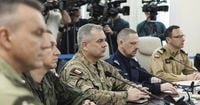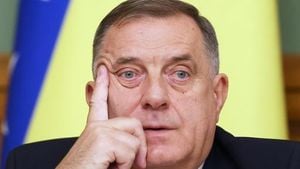In a dramatic escalation along NATO’s eastern frontier, multiple Russian drones breached Polish airspace on September 10, 2025, triggering a swift and coordinated military and diplomatic response from the alliance. The incident, which followed just three days after Russia’s largest aerial assault on Ukraine since the full-scale invasion began in 2022, marked the first time NATO aircraft have engaged enemy drones in alliance territory during the ongoing conflict, according to CTV News and NPR.
As the Russian drones crossed into Polish—and by extension, NATO—airspace, Polish and Dutch fighter jets scrambled into action. Polish F-16s and Dutch F-35s, supported by Italian AWACS surveillance planes and a refueling aircraft, shot down several of the intruding drones. The rapid military response underscored the seriousness with which NATO views any violation of its members’ borders, but it was the diplomatic maneuver that followed which truly signaled the gravity of the situation.
Polish Prime Minister Donald Tusk addressed Parliament, confirming that Poland had invoked Article 4 of the North Atlantic Treaty. This move, as reported by The Associated Press and CBC, set the stage for urgent consultations at NATO headquarters in Brussels. The North Atlantic Council—the alliance’s main decision-making body, comprised of ambassadors from all 32 member states—convened to discuss the threat and consider possible responses.
But what exactly does invoking Article 4 mean, and why is it significant? Article 4 is one of the shortest clauses in NATO’s founding treaty, established in 1949 in the aftermath of World War II. It states: “The Parties will consult together whenever, in the opinion of any of them, the territorial integrity, political independence or security of any of the Parties is threatened.” Unlike the more famous Article 5—which commits the alliance to collective defense if a member is attacked—Article 4 is fundamentally about urgent consultation and coordination in the face of potential threats.
Bob Deen, an analyst at the Clingendael think tank in The Hague, explained to the Associated Press that Article 4 is “designed to promote better coordination and understanding within the alliance on external threats. It gives all allies the opportunity to urgently put certain threats or developments on the agenda of the North Atlantic Council.” In other words, Article 4 is a diplomatic alarm bell, allowing any member to demand a meeting if they feel threatened.
Poland’s decision to invoke Article 4 is not without precedent, but it is far from routine. The country previously called for consultations under Article 4 on March 3, 2014, following Russia’s annexation of Crimea, and again on February 24, 2022, after Moscow’s full-scale invasion of Ukraine. On that latter occasion, Poland joined Bulgaria, Czechia, Estonia, Latvia, Lithuania, Romania, and Slovakia in seeking urgent talks. According to NPR and CTV News, Article 4 has been invoked only seven times in NATO’s history, with Turkey responsible for five of those requests between 2003 and 2020 due to threats from Syria and Iraq.
Rose Gottemoeller, former deputy secretary-general of NATO, told NPR that Article 4 “is just to consult together and to discuss the situation and exactly what happened and try to come to some conclusion. It is not necessarily, by any means, a prelude to invocation of Article 5.” She emphasized that while Article 4 and Article 5 are related, one does not automatically lead to the other. “Article 5 has only been invoked once, in response to the 9/11 attacks on the United States, immediately bypassing article 4,” Deen noted in comments to the Associated Press. “In other words: Article 4 can be invoked without triggering Article 5, and vice versa.”
The distinction is crucial. While Article 5 is NATO’s famous collective defense pledge—an attack on one is considered an attack on all—Article 4 is more about gathering the family around the table to assess the threat and weigh options. It conveys a seriousness of concern, as Gottemoeller put it, and signals to both allies and adversaries that the alliance is taking the situation gravely and is prepared to develop appropriate responses.
The military aspect of the response was notable not just for its scale, but for its speed and multinational character. According to NPR, the engagement involved Polish F-16s, Dutch F-35s, Italian AWACS planes, and a refueling aircraft—a clear demonstration that NATO’s air defense network is robust and ready to react. The fact that this was the first time NATO planes have engaged enemy drones in alliance airspace during the Ukraine war added to the sense of urgency and historic significance.
As for the Russian side, the official response was characteristically ambiguous. The Russian Ministry of Defence stated that “the destruction of targets in Poland was not planned,” implying that the drones may have strayed into Polish airspace by accident. Belarusian authorities claimed that electronic warfare jamming may have caused the drones to deviate from their intended paths, and even warned Poland about the risk. Still, some Western analysts, including Gottemoeller, suggested that Moscow could have been probing NATO’s air defenses to see how the alliance would react. “That’s, I think, the decision that NATO’s weighing now. What exactly was this? Was this intentional or was it an accident?” she said.
The incident has raised uncomfortable questions for NATO policymakers. Was the drone incursion a technical mishap, or a deliberate test of alliance resolve? And if such violations become more frequent, how should NATO calibrate its responses to avoid escalation while maintaining deterrence?
For Poland, the episode is a stark reminder of its vulnerability on the front line of the alliance. The country has been one of the most vocal supporters of Ukraine since the Russian invasion began, and its proximity to the conflict has made it a frequent target of Russian saber-rattling. By invoking Article 4, Warsaw sent a clear message: any threat to its territory will be treated as a threat to the entire alliance, and will be met with unity and resolve.
For NATO as a whole, the events of September 10, 2025, reaffirmed the importance of both military readiness and diplomatic coordination. The alliance’s ability to respond quickly—both in the air and around the negotiation table—serves as a deterrent to would-be aggressors and a reassurance to its members. The consultations under Article 4 may not have led to immediate military escalation, but they demonstrated that NATO takes any encroachment on its territory seriously and stands ready to act as one.
As tensions continue to simmer along NATO’s eastern border, the alliance’s measured but firm response to the drone incursion sends a message that, while it does not seek conflict, it will not hesitate to defend its members—through consultation, coordination, and, if necessary, collective action.






